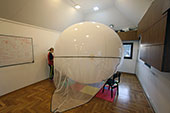
"Tethered" Aerostat
Details
For several decades now Aero Drum Ltd is a supplier of tethered Aerostats to various clients and partners worldwide. We are specialized in design and production of carrier only - Aerostat, stabilization sail, main line (with or without internal power cable), Aluminum base for ... your remote sensing equipment in the stable point between the Aerostat and main line, and rest related to the Aerostat system itself. Our Aerostat Surveillance Systems are used for: - Intelligence Gathering – Reconnaissance – Research - Force Protection - Border Port Security - Beyond Line of Sight (BLOS) Communication Relays - Situational Awareness - Rapid Acquisition - Disaster Response - Incident Awareness & Assessment - Monitoring Air Quality & Atmospheric Conditions - Critical Infrastructure Security - Various Atmospheric measurements - Wild life count - Wild life monitoring and filming, and many more applications Structural integrity and genuine design solutions - The envelope of our Aerostats is made out of High-quality Polyurethane (TPU) film imported for UK or USA. Three thicknesses are mainly used 100, 125 and 150 microns. Double or even triple welding technology process is guarantying that the helium permeability is 0.5 maximum daily regardless to the volume. We care about your helium or hydrogen expenses.Aerostats are a type of lighter-than-air (LTA) aircraft that remain aloft primarily through the use of buoyancy provided by a gas-filled envelope. They are commonly referred to as "tethered" or "unmanned" balloons. Aerostats have been used for various purposes, including military surveillance, telecommunications, and scientific research. A typical aerostat consists of a large envelope filled with a lighter-than-air gas, such as helium or hydrogen, which provides the buoyancy necessary to lift the aerostat off the ground. The envelope is usually made of strong, lightweight materials such as nylon or polyester. The aerostat is usually attached to the ground by a tether or mooring cable, which also serves to provide stability and control. Aerostats are often used for surveillance purposes, particularly in military applications. They can be equipped with various sensors, cameras, and communication equipment to monitor and collect information from the surrounding area. Since aerostats can remain airborne for long periods, they offer a cost-effective and persistent surveillance solution, especially in areas where infrastructure is limited or challenging. One of the advantages of aerostats is their ability to operate at high altitudes, providing an elevated vantage point for surveillance or communication purposes. They can stay aloft for days or even weeks at a time, depending on the design and operational requirements. However, they are subject to weather conditions, and strong winds can affect their stability and performance. Aerostats are also used in the field of telecommunications, particularly for providing wireless connectivity in remote areas or disaster-stricken regions where traditional infrastructure may be damaged or absent. By carrying communication equipment, such as cellular base stations or Wi-Fi transmitters, aerostats can establish temporary networks and enable connectivity over a wide area. In summary, aerostats are gas-filled, lighter-than-air aircraft that are tethered to the ground. They find applications in military surveillance, telecommunications, and scientific research, offering persistent aerial platforms with the ability to operate at high altitudes for extended periods.
5 kg Zeppelin shaped Aerostat for CIRA Institut Italy

2 kg Ellipsoid Aerostat at Doha Fair

RC safety valve (several sizes depending on Aerostat volume) that is set in every envelope is a security that will keep your expensive equipment. Our safety valves can be RC operated or integrated in your own onboard systems.


Main line is polyester Dyneema starting at 4 mm up to 10 mm depending on the Aerostat volume. We have also the main line with power wires integrated in the core of the line. This is important feature for prolonged autonomy (days). The main line is Polyester (waterproof) Dyneema or Dacron quality depending on Aerostat volume. The T aluminum shape is a base for your remote sensing equipment. It is situated between the main line and Aerostat harness system. This is a stable point and vibration free position in the complete system.

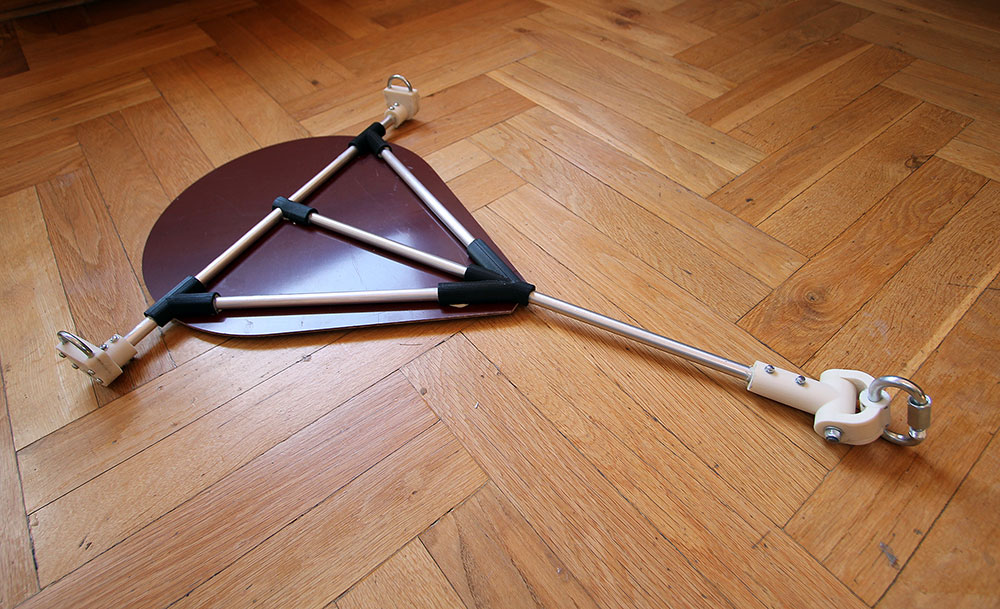
Specification per Aerostat System (regardless to payload capacity)
- - Ellipsoid or Zeppelin shaped Aerostat
- - 100, 125 or 150 microns Polyurethane film
- - All attachments set on the envelope
- - Double welding technology
- - Helium permeability 0.5% per day on total volume per day – guarantied
- - Stabilization sail SwissTulle Polyester mesh
- - Safety valve set on top of the envelope
- - Scoprega filling valve
- - Auto leveling System of the Aerostat on winds
- - Aluminum base for your equipment in the stable point between the balloon and main line
- - Main line Polyester for 4 to 10 mm
- - Rest Balloon related accessories
Compliant to FAA and EASA Safety regulations for Blimps and Drones. Totally un-harmful for the user, other people and environment.
Automatic Leveling System – Originally developed during years of field work to allow to the aerostat to respond to wind changes and level itself regardless to operators. This way it is always turned into wind resulting in lowest aerodynamic resistance possible what directly affects good stability.
0.5 kg Ellipsoid Aerostat
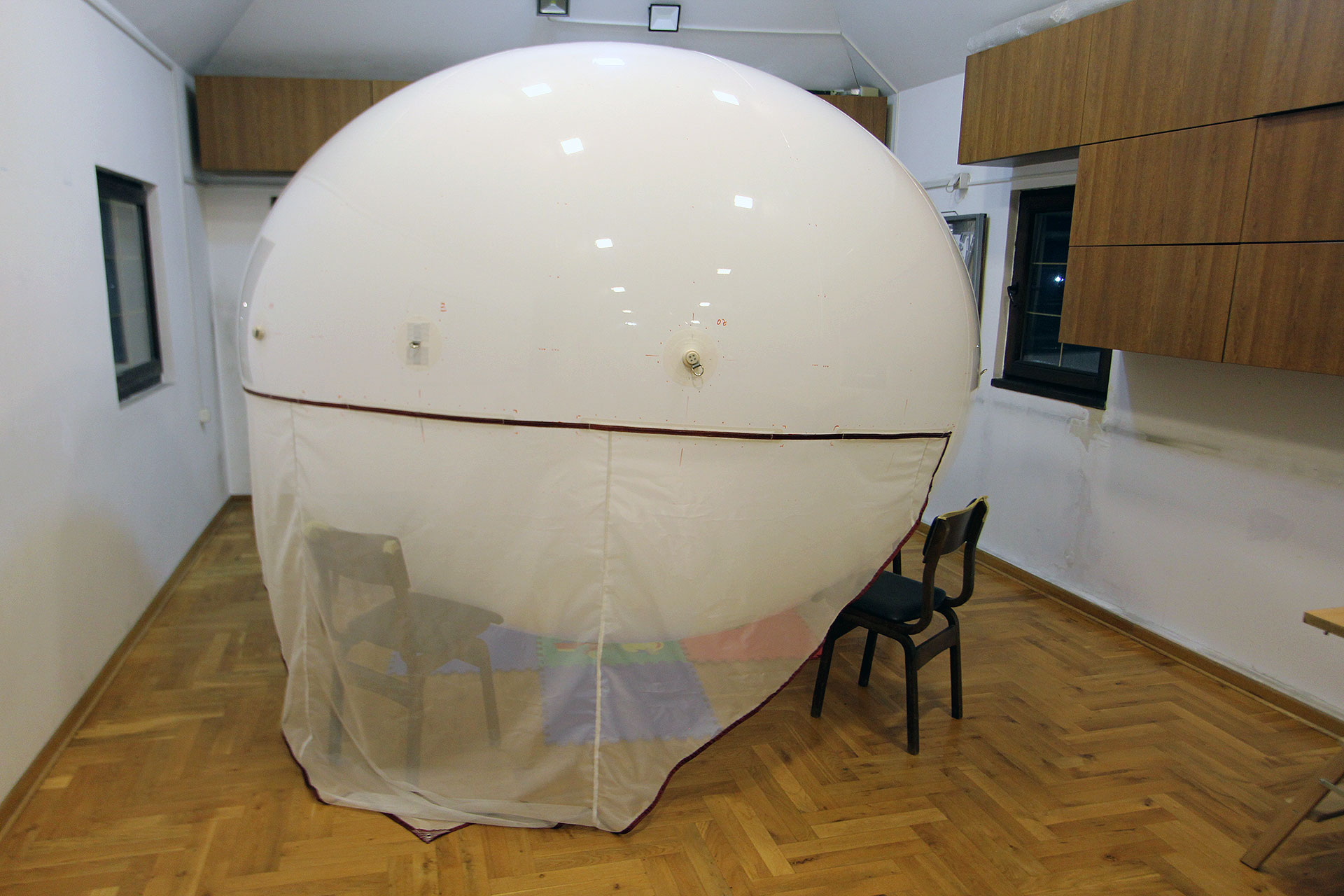
5 kg Ellipsoid Aerostat

10 kg Aerostat finishing works

10 kg Aerostat transport container

2 kg payload Aerostat (Ellipsoid shape)
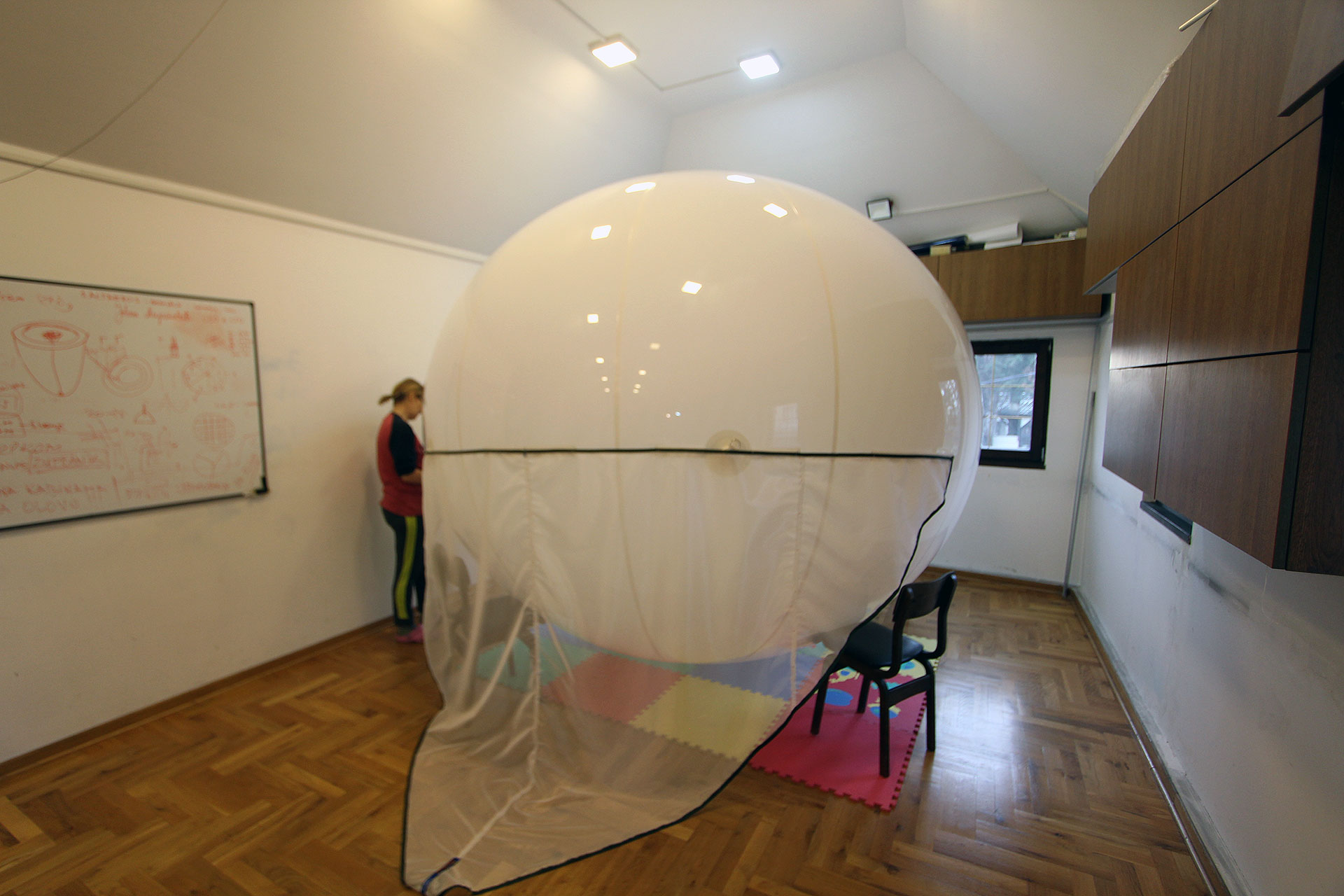
2 kg payload Aerostat (Zeppelin shape)
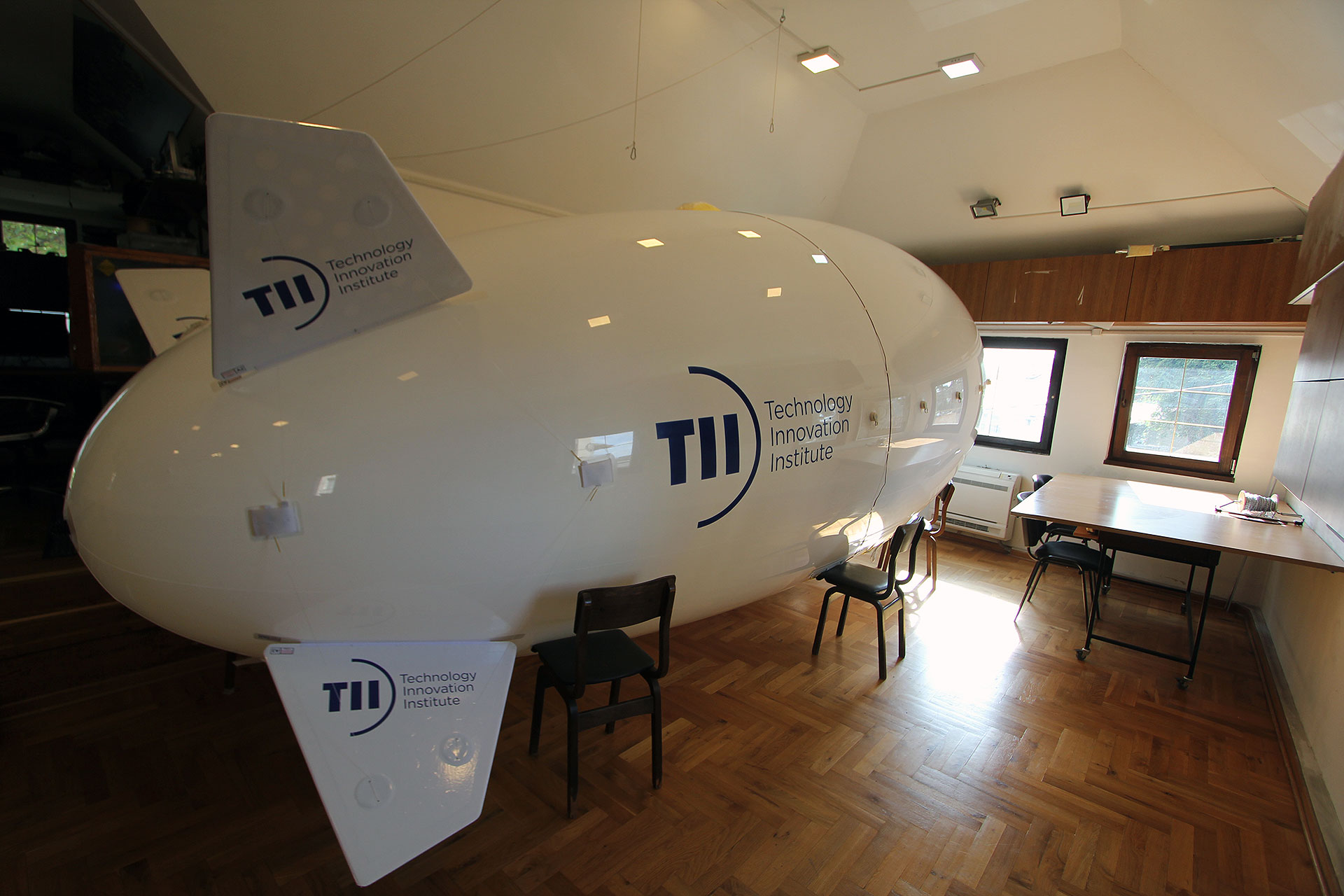

| Aerostat Payload | 0.5 kg | 2 kg | 5 kg | 10 kg | Over 10 kg |
|---|---|---|---|---|---|
| Ellipsoid/Zeppelin shape | Ellipsoid 2.8 x 2.8 x 2 m | Ellipsoid 3.5 x 3.5 x 2.8m Zeppelin 6 x 2.5m | Ellipsoid 4.5 x 4.5 x 3.5m Zeppelin 12 x 2.5m | Ellipsoid 5 x 5 x 3.7 m | Custom design |
| Recomended Maximal wind velocity ** | 15 km⁄h + | 25 km⁄h + | 35 km⁄h + | 45 km⁄h + | Custom design |
| Volume m3 | Ellipsoid 9 m3 | Ellipsoid 18 m3 Zeppelin 16 m3 | Ellipsoid 37 m3 Zeppelin 45 m3 | Ellipsoid 48 m3 | Custom design |
| Stabilization system | Auto Stabilization ©® | Auto Stabilization ©® | Auto Stabilization ©® | Auto Stabilization ©® | Custom design |
| Safety valve diameter | 45 mm | 45 mm | 45 mm | 60 mm | Custom design |
| Envelope film | TPU UK 100 µ | TPU UK 125 µ | TPU UK 125 µ | TPU UK 150 µ | ⁄ |
| Main line*** | 5 mm Polyester | 5 mm Polyester6 mm Polyester | 8 mm Polyester | ⁄ | |
| Main line length | 100 m | 200 m | 200 m | 300 m | ⁄ |
| Assembly Tech. | Ultrasonic Welding (UFW) | Ultrasonic Welding (UFW) | Ultrasonic Welding (UFW) | Ultrasonic Welding (UFW) | ⁄ |
| Equipment base | 8 mm Aluminium | 8 mm Aluminium | 10 mm Aluminium | 15 mm Aluminium | ⁄ |
| Price | 6.730 Euro ⁄ 7.700 USD | 9.780 Euro ⁄ 10.639 USD | 17.627 Euro ⁄ 19.175 USD | 29.311 Euro ⁄ 31.420 USD | ⁄ |
- *Exact USD value on purchase day/date
- **Our Aerostats can stand higher winds than stated above as they are structurally robust and double checked during production. This limit is advisable for prolonged use of the Aerostat
- ***Main line diameter without internal power wires
- Note: Prior to any order we strongly recommend that we talk on Skype or other to understand what are your particular needs and expectations from the Aerostat System.
Photos
10 kg payload Aerostat
5 kg Zeppelin shaped Aerostat for CIRA Institut Italy
Aerostats overview
Nautical use of Aerostats
A short explanation of what Aerostats are
Aerostats are aerial vehicles that use buoyancy to stay aloft in the atmosphere. They are typically lighter-than-air vehicles, meaning they are able to float because their overall density is less than that of the surrounding air. This buoyant force is generated by displacing a volume of air greater than the weight of the vehicle and its payload. Aerostats have been used for various purposes, including surveillance, communication, research, and even entertainment. There are two main types of aerostats: balloons and airships. 1. Balloons: Balloons are the simplest form of aerostats. They are typically large, gas-filled bags that rise in the air due to the difference in density between the gas inside the balloon (often helium or hydrogen) and the surrounding air. Balloons have been used for recreational purposes, scientific research, and even as platforms for various experiments. 2. Airships: Airships are more complex aerostats that have an internal structure and propulsion system. They are often called dirigibles or zeppelins. Airships can be divided into two categories: rigid and non-rigid. Rigid airships have a framework inside the gas envelope to maintain their shape, while non-rigid airships rely on the pressure of the lifting gas to maintain their form. Aerostats have been used for various applications throughout history and continue to be used in modern times: • Surveillance and Communication: Aerostats have been used as surveillance platforms to monitor large areas, border regions, and even during wartime. They can carry sensors, cameras, and communication equipment to provide a stable platform for observation and communication relays. • Advertising and Entertainment: In the past, airships were used for advertising purposes, displaying company logos and messages on their exteriors. Additionally, airship rides and tours have been used for entertainment and tourism. • Scientific Research: Scientists have used aerostats to conduct research in the atmosphere, including studying atmospheric conditions, taking atmospheric measurements, and collecting data on climate and weather patterns. • Disaster Response: Aerostats can serve as communication and surveillance platforms during natural disasters or emergencies, helping authorities assess the situation and coordinate rescue efforts. • Aerial Photography and Filming: Aerostats can provide stable platforms for capturing aerial photographs and videos, useful in filmmaking, photography, and mapping applications. It's important to note that the use of hydrogen gas in early airships led to several high-profile accidents due to its flammability. As a result, helium, a non-flammable gas, has become the preferred choice for lifting gas in modern aerostats.
More Products
Check out all other products we have in store for you.






















